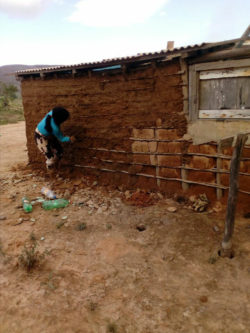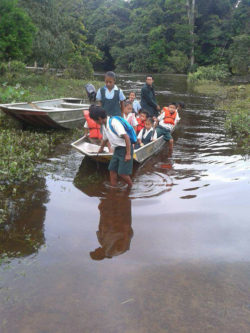Although the water has not yet completely drained from the land, things are beginning to return to a state of normalcy for residents of the flood-hit communities of regions seven and eight, some of whom have begun rebuilding their homes.
“People are starting to pick up their life again and build,” Michael McGarrell, of the Amerindian Peoples’ Association (APA) told Stabroek News yesterday. This, he related, has been demonstrated through the efforts of villagers to reconstruct their homes, and the return of students to schools. “I just want to really point out the resilience of the people up there, they just stood through this difficult time.

I think people are just standing tall and are trying to put their lives back together, putting their pieces back together,” McGarrell said, while noting that the APA continues to monitor the situation in the regions, and there have been reports that the water is receding and the weather has improved.
According to data collected by the Civil Defence Commission (CDC), 3,274 residents in Potaro-Siparuni (Region Eight) were affected by recent flashfloods, which resulted in 266 farms and 56 houses being destroyed. The extent of the effects in Cuyuni-Mazaruni (Region Seven) is yet to be determined.
Kester Craig, Deputy Director-General of the CDC, said yesterday that engineers who ventured into Region Eight to conduct an assessment of the infrastructural damage should have a comprehensive report by today, which will inform what interventions are necessary for the region.
Craig related that the water has since receded from the residential areas, but some farmlands still remain flooded.
Asked how long he foresees the need for relief operations to the affected communities, Craig said that such would be difficult to ascertain given the fact that with it being the rainy season, there remains an ever-present threat of the water rising again and impacting efforts.
Noting that many of the families in the villages are subsistence farmers, McGarrell spoke of the possible long-term effects the disaster may have on the livelihood of residents in the communities.
He noted that persons have begun reaping the cassavas from their waterlogged farms before they begin to rot.
“If they can process it into farine or even cassava bread and the drinks that they make, then they can be able to use it now but if they leave it in the ground then they won’t be able to use it and this can be potentially a big problem because we know that they are dependent on the food, the cassava as their staple diet, and now that their farms have been damaged, it means that for the next couple of months it’s going to be hard,” he said.
Mc Garrell stated that in the meantime, efforts are being organized to mobilize communities to supply the villages with cassava and cassava products, even as he noted that residents of Campbelltown, Mahdia, in the spirit of goodwill, will be processing cassava bread and farine to send over to the communities.
Ground station

Expressing his content that the CDC has set up a ground station in the region from which they can coordinate their efforts, McGarrell acknowledged that the long-term effects of the flood cannot yet be known, and so the CDC’s presence in the region is important for helping residents to understand how relief efforts can be organized.
“…we believe that the presence of the CDC needs to be there for a little more extended period and what they can do as well at this time is to help people understand how relief efforts are done and how they go about doing assistance during disaster periods because I think that this may not be the last time and we need to be prepared for when it comes again,” McGarrell shared.
He further stated that he thought the response time to the disaster could have been a lot better and added that while he recognizes there are gaps in the processes and protocols guiding such efforts, room for improvement does exist, and the process can be improved through collaboration.
“So we are continuing to support the CDC in its effort to collect donations. We are still open to picking up donations here at our office and channeling them to the CDC so that the people can get as much as they really need at this time,” McGarrell said.
McGarrell made a call for more children’s items to be donated, including uniforms and school supplies, and even baby formula.
Meanwhile, Craig said the CDC continues to receive donations from corporate entities and private citizens, which are combined with resources provided by the government to create hampers.
It was reported yesterday that floodwaters continued receding in all areas affected by flooding in Region Eight, with water fully receding in some communities. It was stated that with this recession came an increase in water on the land in several Region Seven communities.
For this reason, the CDC established a Forward Operations Base in neighbouring Kamarang, Cuyuni- Mazaruni (Region Seven) to bring relief to the residents in the affected areas, according to a Ministry of the Presidency release.
The Regional Democratic Council and the CDC have been able to facilitate joint field visits to several of the flood affected communities, dispatched 62 food hampers, 100 collapsible water bottles, cleaning and medical supplies to Kamarang, to be distributed to the flood-affected communities.
Further, two planes laden with supplies, including 116 food hampers, were dispatched to the Operations Base yesterday for distribution.
Ministry of Public Health and the Pan American Health Organization (PAHO) officials yesterday arrived in Orinduik to support other health officials, who were in the region since Friday. They will continue to conduct health assessments and medical outreaches in the affected areas even as medical supplies are being shuttled in.
Additionally, the team of engineers from the Guyana Defence Force and the Guyana Water Incorporated who travelled to the villages of Itabac and Kanapang on Tuesday to conduct an assessment of the damaged roads and buildings, and to facilitate water quality testing has extended their stay to include the other affected villages.
Efforts by the Ministry of Agriculture are underway to take supplies to the farmers in Region Eight who suffered losses in last week’s flashfloods which destroyed 266 farms.





